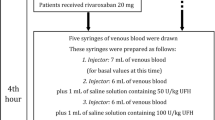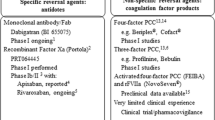Abstract
Efficient and safe anticoagulation is crucial in patients requiring percutaneous coronary intervention (PCI) or extracorporeal circulation during cardiac surgery. Although new anticoagulant strategies have emerged for PCI as alternatives to the established treatment with heparins, the development of new anticoagulants with an improved efficacy/safety ratio is still necessary. Our study compared the efficacy of the novel, dual-acting, neutralizable FIIa/FXa-inhibitor EP217609C101 (EP) at 2, 1.2, 0.9, and 0.6 μg/ml to unfractionated heparin (UFH), enoxaparin, and fondaparinux in preventing cardiac catheter thrombosis under in vitro conditions. Blood drawn by venepunction from healthy male volunteers (n = 10) pretreated with 500 mg aspirin orally was treated with the anticoagulant to test and continuously circulated through a cardiac catheter for 60 min or until the catheter became blocked by thrombotic debris. Anticoagulant efficacy was assessed by thrombus weight, electron microscopic features of the developing thrombi, and laboratory parameters. Whereas UFH, enoxaparin, EP 2, and EP 1.2 μg/ml secured maximum circulation times, statistically significant premature catheter occlusions were observed for EP 0.9, EP 0.6 μg/ml, and fondaparinux. The UFH group and both high-dose concentrations of EP showed significantly lower thrombus weights than the low-dose concentrations of EP and fondaparinux, (p ≤ 0.05). On electron microscopic analysis of the thrombotic debris no differences were observed in erythrocyte deposition between UFH, enoxaparin, and all EP concentrations tested. A significant reduction in fibrin deposition was achieved by UFH and EP 2 μg/ml but no significant differences in platelet deposition were found, except for a significant reduction for EP 0.6 μg/ml. Our in vitro study showed that EP217609C101 is a promising new drug that is dose-dependently superior to classical (UFH, enoxaparin) and newer (fondaparinux) drugs in preventing heart catheter thrombosis.









Similar content being viewed by others
References
Eikelboom JW, Anand SS, Malmberg K, Weitz JI, Ginsberg JS, Yusuf S (2000) Unfractionated heparin and low-molecular-weight heparin in acute coronary syndrome without ST elevation: a meta-analysis. Lancet 355(9219):1936–1942
Chesebro JH, Zoldhelyi P, Badimon L, Fuster V (1991) Role of thrombin in arterial thrombosis: implications for therapy. Thromb Haemost 66:1–5
Anderson JL, Adams CD, Antman EM, Califf RM, Chavey WE II, Fesmire FM, Hochman HJ, Levin TN, Lincoff AM, Peterson ED, Theroux P, Wenger NK, Wright RS, Smith SC Jr (2011) American College of Cardiology Foundation/American Heart Association Task Force on Practice Guidelines. 2011 ACCF/AHA focused update incorporated into the ACC/AHA 2007 Guidelines for the Management of Patients with Unstable Angina/Non-ST-Elevation Myocardial Infarction: a report of the American College of Cardiology Foundation/American Heart Association Task Force on Practice Guidelines developed in collaboration with the American Academy of Family Physicians, Society for Cardiovascular Angiography and Interventions, and the Society of Thoracic Surgeons. J Am Coll Cardiol 57(19):e215–e367
Canadian Cardiovascular Society; American Academy of Family Physicians; American College of Cardiology; American Heart Association, Antman EM, Hand M, Armstrong PW, Bates ER, Green LA, Halasyamani LK, Hochman JS, Krumholz HM, Lamas GA, Mullany CJ, Pearle DL, Sloan MA, Smith SC Jr, Anbe DT, Kushner FG, Ornato JP, Pearle DL, Sloan MA, Jacobs AK, Adams CD, Anderson JL, Buller CE, Creager MA, Ettinger SM, Halperin JL, Hunt SA, Lytle BW, Nishimura R, Page RL, Riegel B, Tarkington LG, Yancy CW. 2007 focused update of the ACC/AHA 2004 guidelines for the management of patients with ST-elevation myocardial infarction: a report of the American College of Cardiology/American Heart Association Task Force on Practice Guidelines. J Am Coll Cardiol. 2008 15;51(2):210–47
Silber S, Albertsson P, Avilés FF, Camici PG, Colombo A, Hamm C, Jørgensen E, Marco J, Nordrehaug JE, Ruzyllo W, Urban P, Stone GW, Wijns W, Task force for percutaneous coronary interventions of the European Society of Cardiology (2005) Guidelines for percutaneous coronary interventions. The task force for percutaneous coronary interventions of the European Society of Cardiology. Eur Heart J 26(8):804–847
Montalescot G, White HD, Gallo R, Cohen M, Steg PG, Aylward PE, Bode C, Chiariello M, King SB 3rd, Harrington RA, Desmet WJ, Macaya C, Steinhubl SR, STEEPLE Investigators (2006) Enoxaparin versus unfractionated heparin in elective percutaneous coronary intervention. N Engl J Med 355(10):1006–1017
Natarajan MK, Velianou JL, Turpie AG, Mehta SR, Raco D, Goodhart DM, Afzal R, Ginsberg JS (2006) A randomized pilot study of dalteparin versus unfractionated heparin during percutaneous coronary interventions. Am Heart J 151(1):175
Warkentin TE (2007) Heparin-induced thrombocytopenia. Hematol Oncol Clin North Am 21(4):589–607
Warkentin TE, Levine MN, Hirsh J, Horsewood P, Roberts RS, Gent M, Kelton JG (1995) Heparin-induced thrombocytopenia in patients treated with low-molecular-weight heparin or unfractionated heparin. N Engl J Med 332(20):1330–1335
Fifth Organization to Assess Strategies in Acute Ischemic Syndromes Investigators, Yusuf S, Mehta SR, Chrolavicius S, Afzal R, Pogue J, Granger CB, Budaj A, Peters RJ, Bassand JP, Wallentin L, Joyner C, Fox KA (2006) Comparison of fondaparinux and enoxaparin in acute coronary syndromes. N Engl J Med 354(14):1464–1476
Stone GW, White HD, Ohman EM, Bertrand ME, Lincoff AM, McLaurin BT, Cox DA, Pocock SJ, Ware JH, Feit F, Colombo A, Manoukian SV, Lansky AJ, Mehran R, Moses JW, Acute Catheterization and Urgent Intervention Triage strategy (ACUITY) trial investigators (2007) Bivalirudin in patients with acute coronary syndromes undergoing percutaneous coronary intervention: a subgroup analysis from the Acute Catheterization and Urgent Intervention Triage strategy (ACUITY) trial. Lancet 369(9565):907–919
Wolzt M, Weltermann A, Nieszpaur-Los M, Schneider B, Fassolt A, Lechner K, Eichler HG, Kyrle PA (1995) Studies on the neutralizing effects of protamine on unfractionated and low molecular weight heparin (Fragmin) at the site of activation of the coagulation system in man. Thromb Haemost 73(3):439–443
Yusuf S, Mehta SR, Chrolavicius S, Afzal R, Pogue J, Granger CB, Budaj A, Peters RJ, Bassand JP, Wallentin L, Joyner C, Fox KA, OASIS-6 Trial Group (2006) Effects of fondaparinux on mortality and reinfarction in patients with acute ST-segment elevation myocardial infarction: the OASIS-6 randomized trial. JAMA 295(13):1519–1530
Schlitt A, Rupprecht HJ, Reindl I, Schubert S, Hauroeder B, Carter JM, Peetz D, Kropff SS, Maegdefessel L, Russ M, Schmidt H, Ebelt H, Werdan K, Buerke M (2008) In-vitro comparison of fondaparinux, unfractionated heparin, and enoxaparin in preventing cardiac catheter-associated thrombus. Coron Artery Dis 19(4):279–284
Steg PG, Jolly SS, Mehta SR, Afzal R, Xavier D, Rupprecht HJ, López-Sendón JL, Budaj A, Diaz R, Avezum A, Widimsky P, Rao SV, Chrolavicius S, Meeks B, Joyner C, Pogue J, Yusuf S, FUTURA/OASIS-8 Trial Group (2010) Low-Dose vs Standard-Dose Unfractionated Heparin for Percutaneous Coronary Intervention in Acute Coronary Syndromes Treated With Fondaparinux: The FUTURA/OASIS-8 Randomized Trial. JAMA. 304(12):1339–1349
Petitou M, Nancy-Portebois V, Dubreucq G, Motte V, Meuleman D, de Kort M, van Boeckel CA, Vogel GM, Wisse JA (2009) From heparin to EP217609: the long way to a new pentasaccharide-based neutralisable anticoagulant with an unprecedented pharmacological profile. Thromb Haemost 102(5):804–810
Nancy-Portebois V. Neutralization of EP217609 anti-factor Xa activity by EP5001 (avidin) in rats. Loos, France: Endotis Pharma; 2010. Report No. EP217609PP12
Nancy-Portebois V. Neutralization of EP217609 anti-factor Xa activity and anti-factor IIa activity by EP5001 (avidin) in dogs. Loos, France: Endotis Pharma; 2010. Report No.: EP217609PP11
Fromes Y, Neuhart E, Krezel C, Gueret P, Petitou M. Neutralization of EP217609 by EP5001 (avidin) in an extracorporeal circulation model in dogs. Loos, France: Endotis Pharma; 2010. Study No.: EP217609PP20
Neuhart E, Krezel C, Van Giersbergen P, Fuseau E. Monocenter, randomized, double-blind, placebo-controlled, single ascending dose study to assess the pharmacokinetics, pharmacodynamics, safety and tolerability of intravenous EP217609 and EP42675 in healthy male subjects. Loos, France: Endotis Pharma: 2010. Study EP217609C102
Martin S. Evaluation of human cytochrome P450 inhibitory properties of EP217609: In vitro experiments. Saint Grégoire, France: Xenoblis; 2009. Report No.: PR8188/CC0086–EP217609PM01
Lopez B. Evaluation of human cytochrome P 450 induction properties of EP217609: In vitro experiments. Saint Grégoire, France: Xenoblis; 2009. Report No.: PR8187/CC0085–EP217609PM02
Motte V, Mazinghien R. Quantification of EP217609 in citrated dog plasma through its anti-Factor Xa activity. Loos, France: Endotis Pharma; 2009. Report No.: TM-BA09-003.1
Motte V, Mazinghien R. Quantification of EP217609 in citrated dog plasma through its anti-Factor IIa activity. Loos, France: Endotis Pharma; 2009. Report No.: TM-BA09-011.1
Motte V, Mazinghien R. Quantification of EP217609 in citrated rat plasma through its anti-Factor Xa activity. Loos, France: Endotis Pharma; 2009. Report No.: TM-BA09-006.1
Motte V, Mazinghien R. Quantification of EP217609 in citrated rat plasma through its anti-Factor IIa activity. Loos, France: Endotis Pharma; 2009. Report No.: TM-BA09-013.1
Raaz U, Kaeberich A, Maegdefessel L, Buerke M, Busshardt M, Schubert S, Russ M, Plehn A, Ebelt H, Werdan K, Schlitt A (2010) The direct thrombin inhibitor argatroban effectively prevents cardiac catheter thrombosis in vitro. Thromb Haemost 103(4):808–814
Raaz U, Buerke M, Busshardt M, Maegdefessel L, Plehn A, Hauroeder B, Werdan K, Schlitt A (2010) Efficacy of enoxaparin, certoparin and dalteparin in preventing cardiac catheter thrombosis: an in vitro approach. J Thromb Thrombolysis 29(3):265–270
Maegdefessel L, Buerke M, Schubert S, Reindl I, Michel T, Hauroeder B, Carter JM, Peetz D, Werdan K, Schlitt A (2008) Comparison of bivalirudin, enoxaparin, and unfractionated heparin in preventing cardiac catheter thrombosis. Results of an in vitro study. Thromb Haemost 100(4):693–698
Stone GW, Witzenbichler B, Guagliumi G, Peruga JZ, Brodie BR, Dudek D, Kornowski R, Hartmann F, Gersh BJ, Pocock SJ, Dangas G, Wong SC, Kirtane AJ, Parise H, Mehran R, HORIZONS-AMI Trial Investigators (2008) Bivalirudin during primary PCI in acute myocardial infarction. N Engl J Med 358(21):2218–2230
Meddahi S, Samama MM (2009) Is the inhibition of both clot-associated thrombin and factor Xa more clinically relevant than either one alone? Blood Coagul Fibrinolysis 20(3):207–214
Gould WR, McClanahan TB, Welch KM, Baxi SM, Saiya-Cork K, Chi L, Johnson TR, Leadley RJ (2006) Inhibitors of blood coagulation factors Xa and IIa synergize to reduce thrombus weight and thrombin generation in vivo and in vitro. J Thromb Haemost 4(4):834–841
Giardino EC, Haertlein BJ, de Garavilla L, Costanzo MJ, Damiano BP, Andrade-Gordon P, Maryanoff BE (2010) Cooperative antithrombotic effect from the simultaneous inhibition of thrombin and factor Xa. Blood Coagul Fibrinolysis 21(2):128–134
Stief TW (2008) Kallikrein activates prothrombin. Clin Appl Thromb Hemost 14(1):97–98
Acknowledgments
This study was funded by an unrestricted grant from ENDOTIS© Pharma, France.
Author information
Authors and Affiliations
Corresponding author
Rights and permissions
About this article
Cite this article
Kaeberich, A., Raaz, U., Vogt, A. et al. In vitro comparison of the novel, dual-acting FIIa/FXa-inhibitor EP217609C101, unfractionated heparin, enoxaparin, and fondaparinux in preventing cardiac catheter thrombosis. J Thromb Thrombolysis 37, 118–130 (2014). https://doi.org/10.1007/s11239-013-0938-4
Published:
Issue Date:
DOI: https://doi.org/10.1007/s11239-013-0938-4




